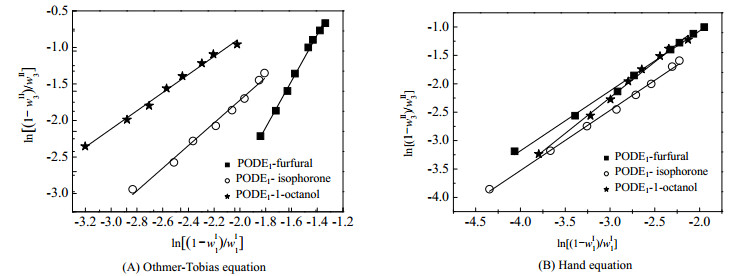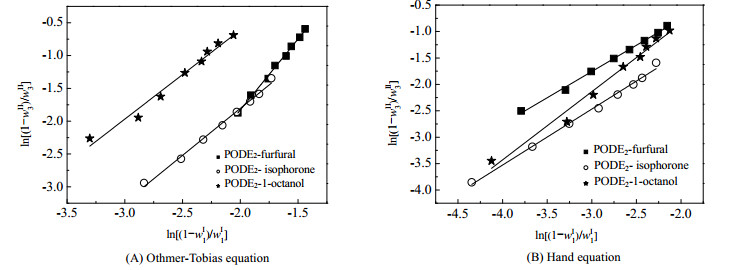聚甲氧基二甲醚(polyoxymethylene dimethylethers,CH3O(CH2O)nCH3,其中n≥1,简称PODEn)[1-2],因其十六烷值平均高达76,具有较高的含氧量,和柴油的理化性质相近、互溶性好且稳定,可直接用作车用柴油而不用改变发动机结构,从而降低柴油车污染物的排放,因此PODE是一种公认的新型绿色清洁柴油添加组分。目前合成聚甲氧基二甲醚的方法主要有3种:甲醇与甲醛、三聚甲醛、多聚甲醛中的一种或几种反应[3],二甲醚与甲醛、三聚甲醛、多聚甲醛中的一种或几种反应[4],甲缩醛(PODE1)与甲醛、三聚甲醛、多聚甲醛中的一种或几种反应[5]。但是这3种反应方式都会有水生成,由于水会与PODE形成共沸物,难以通过简单的蒸馏操作进行分离,而液液萃取分离是一种可探索的分离方法。
可靠的相平衡数据是液液萃取过程设计和优化的基础。庄志海等[6-7]研究了在293.15和313.15 K时水+ PODE1-4+对二甲苯、水+PODE1-4+正己烷三元体系的液液相平衡数据,SHI等[8-9]研究了在293.15 K时水+PODE3+对二甲苯(甲苯或正庚烷)和水+甲缩醛+环己烷(或正庚烷)三元体系体系的液液相平衡数据。根据文献报道[10-12],得知糠醛、异佛尔酮、正辛醇在水溶液中具有良好的萃取能力,在实际的生产中被广泛应用。因此,本研究选择糠醛、异佛尔酮和正辛醇作为从水中提取PODE1-2的萃取剂。
本文测量了常压下,308.15 K时三元体系水+PODE1+糠醛、异佛尔酮和正辛醇,水+PODE2+糠醛、异佛尔酮和正辛醇的联络线数据。运用Hand和Othmer-Tobias方程以检测实验结果的可靠性。此外,使用UNIQUAC[13]模型拟合测量的连接线值,获得二元交互参数。
2 实验材料与方法 2.1 材料实验所用试剂的详细介绍列于表 1中,其中r为体积参数,q为表面积参数。
|
|
表 1 实验药品 Table 1 Chemicals used in the study |
实验在液液相平衡釜中进行的,将一定质量的混合物加入相平衡釜[14]中,剧烈搅拌3 h,然后将混合物静置4 h,以达到三元体系的相平衡状态。通过恒温水浴维持系统温度的恒定,精确度为±0.1 K。采用气相色谱分析有机相和水相,并对每个样品检测至少3次,并将其平均值记作样品组分含量。GUM标准[15]用于测量两个富集相的不确定度。
在三元系统达到稳定后,通过Agilent GC6820气相色谱(热导检测器(TCD)和Porapak N(3 m×3 mm)色谱柱)来测定相平衡数据。在水+PODE1+萃取剂体系中采用异丙醇为内标物,水+PODE2+萃取剂的体系中以1, 4-二氧六环为内标,通过色谱分析来确定各物质的质量浓度。具体分析条件如下所示:以氢气为载体;检测器和气化室保持在523.2 K;色谱柱的初始温度为393.2 K,维持3 min,以15 K·min-1程序升温到503.2 K,并保持2 min。
3 实验结果与讨论 3.1 相平衡数据在常压,308.15 K时测量的水+PODE1+萃取剂(糠醛、异佛尔酮、正辛醇)体系的液液相平衡数据如表 2所示,在本文统一用质量分数来表示溶解度。由表 2数据可知,随着PODE1含量的增加,PODE1在水相和有机相中的质量分数均逐渐增大,且PODE1在有机相中的含量比在水相中增加的多。在常压,308.15 K的条件下测量的水+PODE2+萃取剂(糠醛、异佛尔酮、正辛醇)体系的液液相平衡数据如表 3所示。由表 3数据可知,随着PODE2含量的增加,PODE2在水相和有机相中的质量分数均逐步增大,且PODE2在有机相中的含量比在水相中增加的多。
|
|
表 2 水(1)+PODE1 (2)+萃取剂(3)体系由质量分数表示的液液相平衡数据 Table 2 Experimental LLE data (mass fraction) of the water (1) + PODE1(2) + extractants(3) systems |
|
|
表 3 水(1)+PODE2 (2)+萃取剂(3)体系由质量分数表示的液液相平衡数据 Table 3 Experimental LLE data (mass fraction) of the water (1) + PODE2(2) + extractants (3) systems |
三元相图、联结线如图 1和2所示。从图 1可以看出图中存在很大的两相区域,表明糠醛、异氟尔酮和正辛醇对甲缩醛具有较大的可操作性,可从水中提取和分离PODE1。从图 2可以看出图中存在很大的两相区域,表明糠醛、异氟尔酮和正辛醇对PODE2具有较大的可操作性,可从水中提取和分离PODE2。

|
图 1 水+PODE1+萃取剂体系的三元相图 Fig.1 Ternary phase diagram of water (1) + PODE1 (2) + extractants (3) systems |

|
图 2 水+PODE2+萃取剂体系的三元相图 Fig.2 Ternary phase diagram of water (1) + PODE2 (2) + extractants (3) systems |
分别运用如下方程来计算分配系数D和分离因子S[16],以评价糠醛、异佛尔酮和正辛醇的萃取效果。
| $ D = \frac{{w_2^{\rm I}}}{{w_2^{\rm II}}} $ | (1) |
| $ S = \frac{{{{\left( {\frac{{{w_2}}}{{{w_1}}}} \right)}^{\rm I}}}}{{{{\left( {\frac{{{w_2}}}{{{w_1}}}} \right)}^{\rm II}}}} $ | (2) |
w1Ⅰ和w2Ⅰ分别为水和PODE1或PODE2在有机相中的质量分数;w1Ⅱ和w2Ⅰ分别为水和PODE1或PODE2在水相中的质量分数。PODE的分配系数以及PODE和水的分离因子的值如表 2,表 3所示。结果表明:分配系数均高于1,表明糠醛、异佛尔酮和正辛醇具有较好的提取能力,其分离因子远高于1,表明糠醛、异氟尔酮和正辛醇具有较高的选择性。
3.3 相平衡数据的一致性检验使用Othmer-Tobias和Hand方程[17]检验相平衡数据的一致性:
| $ \ln \left[ {\frac{{w_2^{\rm I}}}{{w_3^{\rm II}}}} \right] = f' + k'\ln \left[ {\frac{{w_2^{\rm II}}}{{w_1^{\rm I}}}} \right] $ | (3) |
| $ \ln \left[ {\frac{{1 - w_3^{\rm I}}}{{w_3^{\rm I}}}} \right] = f + k\ln \left[ {\frac{{1 - w_1^{\rm II}}}{{w_1^{\rm II}}}} \right] $ | (4) |
其中f,f ',k和k'分别为上述方程的参数。w1Ⅰ和w2Ⅱ分别为水和PODE1或PODE2在水相中的质量分数;w2Ⅰ和w3Ⅰ分别为PODE1或PODE2和萃取剂在有机相中的质量分数。该方程的参数和线性相关性R2列于表 4。Othmer-Tobias和Hand方程的线性关系如图 3、图 4所示。拟合结果都表现出较好的线性行为,线性相关的平方R2≥0979 3,表明测量的相平衡数据具有较好的一致性。
|
|
表 4 三元体系的Othmer-Tobias和Hand关联拟合参数 Table 4 Othmer-Tobias and Hand equation parameters of the studied ternary systems |

|
图 3 水+PODE1+萃取剂三元体系的Othmer-Tobias和Hand方程曲线 Fig.3 Othmer-Tobias and Hand plots of the water (1) + PODE1 (2) + extractants (3) ternary systems |

|
图 4 水+PODE2+萃取剂三元体系的Othmer-Tobias和Hand方程曲线 Fig.4 Othmer-Tobias and Hand plots of the water (1) + PODE2 (2) + extractants (3) ternary systems |
采用UNIQUAC模型对本文测量值进行回归。UNIQUAC的体积参数r和表面积参数q[7, 18-20]列于表 1。采用非线性回归法关联UNIQUAC模型最小参数,目标函数OF计算如下:
| $ OF = {\sum\nolimits_{n = 1}^M {\sum\nolimits_{m = 1}^2 {\sum\nolimits_{l = 1}^3 {\left( {{w_{lmn}} - {{\hat w}_{lmn}}} \right)} } } ^2} $ | (5) |
w和
从UNIQUAC模型获得的二元相互作用参数总结在表 5和6中,关联结果绘制在图 1和2中。采用均方根偏差(RMSD)来估计实验数据与模拟数据的一致性。通过计算RMSD < 0.005 3,说明UNIQUAC能够很好地关联水+PODE1/PODE2+萃取剂的液液相平衡数据。公式如下所示:
|
|
表 5 水(1)+PODE1 (2)+萃取剂(3)体系在UNIQUAC模型获得的二元交互参数 Table 5 Binary interaction parameters of UNIQUAC models for water (1) + methylal(2) + extractants(3) systems |
|
|
表 6 水(1)+PODE2 (2)+糠醛或异氟尔酮或正辛醇(3)体系UNIQUAC模型的二元交互参数 Table 6 Binary interaction parameters of UNIQUAC models for water (1) + PODE2(2) + extractants(3) systems |
| $ {\rm{RMSD}} = {\left\{ {\sum\nolimits_{n = 1}^M {\sum\nolimits_{m = 1}^2 {\sum\nolimits_{l = 2}^3 {\frac{{{{\left( {{w_{lmn}} - {{\hat w}_{lmn}}} \right)}^2}}}{{6M}}} } } } \right\}^{{\raise0.7ex\hbox{$1$} \!\ \!\lower0.7ex\hbox{$2$}}}} $ | (6) |
式中的参数M,n,m,l,w和
本文测定了在大气压下308.15 K时水+PODE1+萃取剂(糠醛、异佛尔酮、正辛醇)和水+PODE2+萃取剂(糠醛、异佛尔酮、正辛醇)三元体系的相平衡数据。结果表明,糠醛、异佛尔酮和正辛醇对水溶液中的PODE1和PODE2具有良好的萃取能力。其中糠醛的萃取能力最强。使用Hand和Othmer-Tobias方程对实验数据的可靠性进行检测,结果表明实验数据具有良好的热力学一致性。此外,采用UNIQUAC和NRTL模型对实验数据进行拟合,拟合数据与测量的相平衡数据之间偏差很小。因此,本文测量的相平衡数据能够为采用液液萃取方法获得高纯度的PODE1和PODE2的过程设计和优化提供基础。
| [1] |
SAUDAGAR P S, SURVASE S A, SINGHALL R S. Clavulanic acid: A review[J]. Biotechnology Advances, 2008, 26(4): 335-351. DOI:10.1016/j.biotechadv.2008.03.002 |
| [2] |
KIM D J, KING J A, ZUCCARELLI L, et al. Clavulanic acid: A competitive inhibitor of beta-lactamases with novel anxiolytic-like activity and minimal side effects[J]. Pharmacology, Biochemistry and Behavior, 2009, 93(2): 112-120. DOI:10.1016/j.pbb.2009.04.013 |
| [3] |
陈静, 唐中华, 夏春谷, 等.哑铃型离子液体催化合成聚甲氧基二甲醚的方法: CN101962318 [P]. 2011-02-02. CHEN J, TANG Z H, XIA C G, et al. Method for synthesizing polymethoxy dimethyl ether by dumbbell type ionic liquid: CN101962318[P]. 2011-02-02. |
| [4] |
HAGEN G P, SPANGLER M J. Preparation of polyoxymethylene dimethylethers by acid-activated catalytic conversion of methanol with formaldehyde formed by oxydehydrogenation of dimethyl ether: US6265528[P]. 2001-07-24.
|
| [5] |
HEINER S, ECKHARD S, ROLF P, et al. Method for producing polyoxymethlene dimethyl ethers: US20070260094A1[P]. 2007-11-08
|
| [6] |
庄志海, 张建强, 刘殿华. 聚甲氧基二甲醚+水+正己烷三元体系的液液相平衡[J]. 化工学报, 2016, 67(9): 3545-3551. ZHUANG Z H, ZHANG J Q, LIU D H. Liquid-liquid equilibria for ternary systems polyoxymethylene dimethyl ethers+water+ n-hexane[J]. CIESC Journal, 2016, 67: 3545-3551. |
| [7] |
ZHUANG Z H, ZHANG J Q, LIU X K, et al. Liquid-liquid equilibria for ternary systems polyoxymethylene dimethyl ethers + paraxylene + water[J]. The Journal of Chemical Thermodynamics, 2016, 101: 190-198. DOI:10.1016/j.jct.2016.05.016 |
| [8] |
SHI M D, YU X M, HE G Y, et al. Liquid-liquid equilibrium for the ternary systems water + DMM3 + (p-xylene, toluene, and n-heptane) at different temperatures[J]. The Canadian Journal of Chemical Engineering, 2017, 96(4): 1-10. |
| [9] |
SHI M D, HE G Y, GAN F, et al. Extraction of low concentration aqueous solution of methylal: liquid-liquid equilibrium in water + methylal + (cyclohexane and n-Heptane) ternary systems[J]. Journal of Chemical & Engineering Data, 2017, 62(7): 2183-2190. |
| [10] |
ALBERTO A, BLANCO M, SOTO A. Determination and correlation of liquid–liquid equilibrium data for the quaternary system 1-octanol+2-methoxy-2-methylbutane+water+methanol at 25 ℃[J]. Fluid Phase Equilibria, 1999, 158/159/160(1): 949-960. |
| [11] |
YANG C, LIU H, ZHU C F, et al. Measurement and correlation of ternary (liquid-liquid) equilibria for separation of cyclohexanone from water via isophorone or mesityl oxide[J]. Journal of Chemical & Engineering Data, 2018, 63(1): 178-186. |
| [12] |
WONGSAWA T, HRONEC M, LOTHONGKUN A W, et al. Experiments and thermodynamic models for ternary(liquid-liquid) equilibrium systems of water + cyclopentanone + organic solvents at T = 298.2 K[J]. Journal of Molecular Liquids, 2014, 196: 98-106. DOI:10.1016/j.molliq.2014.03.020 |
| [13] |
JIA B, XIN K, WANG L P, et al. Experiments and thermodynamic models for ternary liquid-liquid equilibrium systems of diethoxymethane + ethanol + water system at different temperatures[J]. Journal of Molecular Liquids, 2017, 242: 907-912. DOI:10.1016/j.molliq.2017.07.092 |
| [14] |
XIN K, SONG Y H, DAI F F, et al. Liquid–liquid equilibria for the extraction of furfural from aqueous solution using different solvents[J]. Fluid Phase Equilibria, 2016, 425: 393-401. DOI:10.1016/j.fluid.2016.06.040 |
| [15] |
Joint Committee for Guides in Metrolog. Evaluation of measurement data - Guide to the expression of uncertainty in measurement 98-3: 2008[S]. Russia: Measurement Techniques, 2008.
|
| [16] |
NARASIGADU C, NADIDOO M, RAMJUGEMATH D. Ternary liquid-liquid equil ibrium data for the water + acetonitrile + {butan-1-ol or 2-methylpropan-1-ol} systems at (303.2, 323.2, 343.2) K and 1 atm[J]. Journal of Chemical & Engineering Data, 2014, 59(11): 3820-3824. |
| [17] |
OTHMER D, TOBIAS P. Liquid-liquid extraction data - the line correlation[J]. Industrial & Engineering chemistry research, 1942, 34(6): 693-696. |
| [18] |
COLOMBO A, BATTILANA P, RAGAINI V, et al. Liquid-liquid equilibria of the ternary systems water + acetic acid +ethyl acetate and water + acetic acid + isophorone (3, 5, 5-trimethyl-2-cyclohexen-1-one)[J]. Journal of Chemical & Engineering Data, 1999, 44(1): 35. |
| [19] |
GILANI H G, GILANI A G, SEYED S L. Solubility and tie line data for the aqueous solutions of butyric acid with 1-octanol and 2-ethyl-1-hexanol at various temperatures[J]. Fluid Phase Equilibria, 2014, 361: 45. DOI:10.1016/j.fluid.2013.10.022 |
| [20] |
XIN K, SONG Y H, DAI F F, et al. Liquid-liquid equilibria for the extraction of furfural from aqueous solution using different solvents[J]. Fluid Phase Equilibria, 2016, 425: 393. DOI:10.1016/j.fluid.2016.06.040 |




